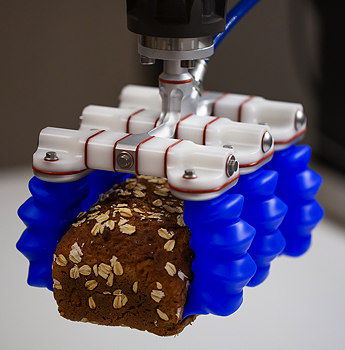- Home » News » Technology News
Flexible robotic gripper works like a chameleon’s tongue

A robotic gripper that holds workpieces in a similar way to how a chameleon’s tongue grabs and holds onto insects, has been developed by Festo. The DHEF “adaptive shape gripper” can pick up and put down objects of many different shapes without needing any manual adjustments.
The gripper is the development of a prototype, called the FlexShapeGripper, that Festo developed in collaboration with the University of Oslo and demonstrated for the first time at the 2015 Hannover Fair.
Unlike mechanical grippers that can only hold specific components, the adaptive shape gripper can handle components of almost any shape and with round geometries. The absence of sharp edges makes it ideal for gripping sensitive objects such as air nozzles or trim strips. In principle, it can pick up several parts at the same time – for example, nuts from a bowl.
The gripper can handle small parts in production machinery and in packaging applications, as well as collaborating with human workers in assembly tasks. There are also potential medical applications as prosthetic extensions.
The adaptive shape gripper has a flexible silicone cap that can fold itself over and grip objects of almost any shape, with diameters from 12-38mm. It is said to create a firm, form-fitting hold. The elastic silicone membrane enables the gripper to adapt to a wide range of geometries. When combined with a pneumatic drive, it requires little energy to achieve a secure grip.

The gripper is designed to be used with a standardised robot interface with integrated air connections. There is a sensor slot for position sensing, and a bayonet lock for easy replacement of the cap.
When a chameleon has an insect in its sights, it shoots out its tongue like a rubber band. Just before the tip of the tongue reaches the insect, it retracts in the middle, while the edges continue to move forwards. This allows the tongue to adapt to the shape and size of the prey and firmly enclose it. The prey sticks to the tongue and is pulled in, as if being caught on a fishing line.
• Soft Robotics, a US company that specialises in soft gripping technologies, has released a modular “kit” that allows users to automate a wide range of soft gripping applications. Using patented materials, the mGrip system can grasp and manipulate items with a dexterity said to be similar to that of a human hand.






